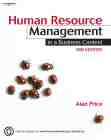
|
|

Bestselling Books |
| US Bestsellers UK Bestsellers France - Meilleurs Ventes Canada Bestsellers Germany Bestsellers |
 Hooked on books? BestBooks.biz features book-related articles, book extracts and book selections from the best books - past and present. Work Discrimination Attorney In Pa Job Birmingham Customer Questionnaire BUY BOOKS ONLINE  Human Resources Management: A Critical Text, 3eJohn Storey (editor)Designed to meet the needs of advanced management students on a variety of courses, the international team of expert contributors provides an in-depth, authoritative, critical and original account of contemporary HRM More information and prices from: Amazon.com - US dollars Amazon.ca - Canadian dollars Amazon.co.uk - British pounds Amazon.de - Euros Amazon.fr - Euros |
High Performance Management Systems - Part 3Adapted from Human Resource Management in a Business Context, 3rd edition (2007) Gardner, Wright and Gerhart (2000) query the nature of the evidence supporting the supposed value of HR initiatives in improving performance: "While extremely promising, this research, with few exceptions, has relied on the survey responses from one knowledgeable informant per company to measure the quantity and quality of firms' human resource management systems. Reliance on just one informant makes the measurement of the human resource management construct susceptible to excessive random (i.e. unreliability) and systematic (i.e. bias) measurement error ...' As they point out, this threatens the validity of the construct that HR practices are directly related to high performance. Paradoxically, however, the two types of error may be having opposite effects. Citing earlier statistical work by Gerhart, they argue that random errors from single- informant surveys may be obscuring and therefore undervaluing the financial benefit of HR practices. Conversely, there is likely to be an over-estimate from systematic errors. Where do these systematic errors come from? Gardner, et al argue that: "This type of error will occur if respondents report HR practices based not on accurate valid estimates, but rather based on an implicit theory that high performing firms must be engaged in progressive HR practices while low performing firms must not be engaged in such practices." They cite the example of a large diversified, perhaps multinational company. If a senior HR person is asked to state the percentage of employees covered by a 'progressive' human resource practice, where does the HR person get the information from? Hopefully from a sophisticated human resource management system, but probably not. Instead, they contend, the respondent will provide an answer based on their own implicit theory of what is happening in the firm. Discussing coverage of this issue in research literature they point out that surveys typically ask for the views of senior managers who, to paraphrase, are likely to believe in their own upbeat propaganda aimed at shareholders and employees. In more academic terms, they say that, surveying the literature, "there is general consensus that executives' descriptions of past events suffer from low reliability." They also point to studies which show that outsiders' judgements of a firm are based on financial performance and conclude that it is reasonable to assume that insiders are also likely to be influenced in the same way. They formulated two hypotheses: 1. The estimated extent of the usage of human resource practices for high-performing firms will be greater than low-performing firms. 2. The evaluation of the effectiveness of the HR function for high-performing firms will be higher than for low performing firms. These hypotheses were tested on line managers, HR executives, MBAs and HR Masters students who were given scenarios of high and low performing companies and asked to rate a range of HR practices. The scenarios did not provide any information on HR practices, so their judgements were based entirely on implicit theories. The conclusion was that the hypotheses were confirmed to some extent in all four groups. This places a question mark on the supposed evidence from much of the survey research on the relationship between HR practices and high performance. References: Gardner, T.M., Wright, P.M. and Gerhart, B.A. (2000) '
The HR-Firm Relationship. Can it be in the Mind of the
Beholder?' CAHRS Working Paper 00-20, Cornell University.
This article is based on Human Resource Management in a Business Context by Alan Price (3rd edition, 2007) . |
 in a Business Context by Alan Price
|
|
|
|
|
|
|
|
|
|
|
|
| Copyright © 2000-2008 Alan Price and BestBooks.biz contributors. All rights reserved. |